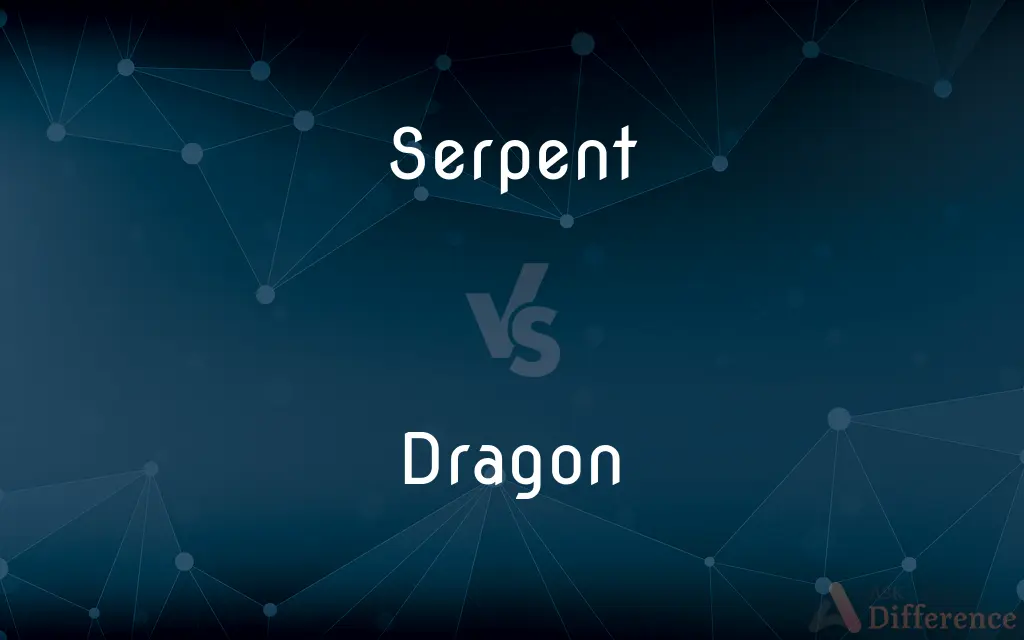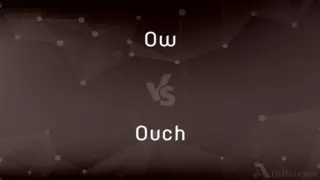Serpent vs. Dragon — What's the Difference?
Edited by Tayyaba Rehman — By Urooj Arif — Updated on March 7, 2024
Serpents are generally legless reptiles, often associated with cunning or treachery, while dragons are mythical creatures with legs, often capable of breathing fire and symbolizing power or wisdom.

Difference Between Serpent and Dragon
Table of Contents
ADVERTISEMENT
Key Differences
Serpents, in the broadest sense, refer to snakes or snake-like creatures, emphasizing their legless form and often being associated with venom or deceit. Dragons, on the other hand, are mythical beings that vary in appearance across cultures but commonly possess legs, wings, and the ability to breathe fire or possess other magical qualities.
In mythology and folklore, serpents are frequently depicted as evil or cunning, embodying chaos or temptation. Dragons, whereas, can symbolize either malevolent forces or wisdom and strength, depending on the culture, with Eastern traditions often viewing them as benevolent.
The habitat and behavior of serpents are grounded in reality, inhabiting diverse environments on earth and displaying behaviors typical of reptiles. Dragons, in contrast, inhabit the realms of mythology and fantasy, often associated with guarding treasures or wielding great power.
Serpents play significant roles in various religious and mythological narratives, often representing fertility or rebirth, as in the case of the Ouroboros symbolizing eternal cycles. Dragons, on the other hand, are central to myths where they often challenge heroes, represent primal forces, or serve as guardians, embodying attributes like wisdom, longevity, and power.
The perception of serpents and dragons reflects cultural attitudes towards these creatures. Serpents are often viewed with fear or suspicion, reflecting their real-world danger and symbolic association with betrayal. Conversely, dragons are revered in many cultures for their mystical attributes and are celebrated in art, literature, and festivals.
ADVERTISEMENT
Comparison Chart
Physical Form
Legless, resembling snakes
Often depicted with legs, wings, and capable of breathing fire
Symbolism
Deceit, danger, fertility
Power, wisdom, malevolence or benevolence
Cultural Perception
Often viewed negatively
Viewed either as wise and good or evil and destructive
Habitat
Real-world environments
Mythical and fantasy realms
Role in Mythology
Temptation, chaos, renewal
Guardianship, challenge, embodiment of primal forces
Compare with Definitions
Serpent
Can be a guardian or protective symbol.
Serpents guard the entrance in ancient mythology.
Dragon
A mythical creature, often fire-breathing with a reptilian appearance.
The dragon guarded the castle's treasure.
Serpent
A term often used for snakes, symbolizing cunning.
The serpent in the garden was more cunning than any beast.
Dragon
Symbolizes power and wisdom in Asian cultures.
The dragon dance is performed to bring luck and prosperity.
Serpent
Associated with healing and rebirth.
The medical caduceus features two serpents entwined.
Dragon
Represents natural elements or forces in mythology.
Dragons controlling the weather is a common theme.
Serpent
Used metaphorically to describe sly or treacherous people.
He was known as a serpent for his deceptive practices.
Dragon
Central to many fantasy stories and legends.
Knights often seek glory by slaying dragons.
Serpent
Represents evil or treachery in many cultures.
Legends often depict the serpent as a betrayer.
Dragon
Used as a symbol of imperial authority in some cultures.
The emperor's throne was adorned with dragon motifs.
Serpent
(Zoology) A snake.
Dragon
Something very formidable or dangerous.
Serpent
Often Serpent In the Bible, the creature that tempted Eve, identified in Christian tradition with Satan.
Dragon
A dragon is a large, serpentine, legendary creature that appears in the folklore of many cultures worldwide. Beliefs about dragons vary considerably through regions, but dragons in western cultures since the High Middle Ages have often been depicted as winged, horned, four-legged, and capable of breathing fire.
Serpent
A subtle, sly, or treacherous person.
Dragon
See Draco2.
Serpent
A firework that writhes while burning.
Dragon
A mythical monster traditionally represented as a gigantic reptile having a long tail, sharp claws, scaly skin, and often wings.
Serpent
(Music) A deep-voiced wind instrument of serpentine shape, used principally from the 1600s to the 1800s, about 2.5 meters (8 feet) in length and made of brass or wood.
Dragon
Any of various lizards, such as the Komodo dragon or the flying lizard.
Serpent
Serpent Serpens.
Dragon
A fiercely vigilant or intractable person.
Serpent
A snake, especially a large or dangerous one.
Dragon
(Archaic) A large snake or serpent.
Serpent
(figurative) A subtle, treacherous, malicious person.
Dragon
A legendary serpentine or reptilian creature.
Serpent
(musical instruments) An obsolete wind instrument in the brass family, whose shape is suggestive of a snake (Wikipedia article).
Dragon
In Western mythology, a gigantic beast, typically reptilian with leathery bat-like wings, lion-like claws, scaly skin and a serpent-like body, often a monster with fiery breath.
Serpent
A kind of firework with a serpentine motion.
Dragon
In Eastern mythology, a large, snake-like monster with the eyes of a hare, the horns of a stag and the claws of a tiger, usually beneficent.
Serpent
To wind or meander
Dragon
An animal of various species that resemble a dragon in appearance:
Serpent
To encircle.
Dragon
(obsolete) A very large snake; a python.
Serpent
Any reptile of the order Ophidia; a snake, especially a large snake. See Illust. under Ophidia.
Dragon
Any of various agamid lizards of the genera Draco, Physignathus or Pogona.
Serpent
Fig.: A subtle, treacherous, malicious person.
Dragon
A Komodo dragon.
Serpent
A species of firework having a serpentine motion as it passess through the air or along the ground.
Dragon
The constellation Draco.
Serpent
The constellation Serpens.
Dragon
(pejorative) A fierce and unpleasant woman; a harridan.
She’s a bit of a dragon.
Serpent
A bass wind instrument, of a loud and coarse tone, formerly much used in military bands, and sometimes introduced into the orchestra; - so called from its form.
Dragon
The (historical) Chinese empire or the People's Republic of China.
Napoleon already warned of the awakening of the Dragon.
Serpent
To wind like a serpent; to crook about; to meander.
Dragon
(figuratively) Something very formidable or dangerous.
Serpent
To wind; to encircle.
Dragon
A type of playing-tile (red dragon, green dragon, white dragon) in the game of mahjong.
Serpent
Limbless scaly elongate reptile; some are venomous
Dragon
A luminous exhalation from marshy ground, seeming to move through the air like a winged serpent.
Serpent
A firework that moves in serpentine manner when ignited
Dragon
A short musket hooked to a swivel attached to a soldier's belt; so called from a representation of a dragon's head at the muzzle.
Serpent
An obsolete bass cornet; resembles a snake
Dragon
A background process similar to a daemon.
Dragon
A variety of carrier pigeon.
Dragon
(slang) A transvestite man, or more broadly a male-to-female transgender person.
Dragon
A fabulous animal, generally represented as a monstrous winged serpent or lizard, with a crested head and enormous claws, and regarded as very powerful and ferocious.
The dragons which appear in early paintings and sculptures are invariably representations of a winged crocodile.
Thou breakest the heads of the dragons in the waters.
Thou shalt tread upon the lion and adder; the young lion and the dragon shalt thou trample under feet.
He laid hold on the dragon, that old serpent, which is the Devil and Satan, and bound him a thousand years.
Dragon
A fierce, violent person, esp. a woman.
Dragon
A constellation of the northern hemisphere figured as a dragon; Draco.
Dragon
A luminous exhalation from marshy grounds, seeming to move through the air as a winged serpent.
Dragon
A short musket hooked to a swivel attached to a soldier's belt; - so called from a representation of a dragon's head at the muzzle.
Dragon
A small arboreal lizard of the genus Draco, of several species, found in the East Indies and Southern Asia. Five or six of the hind ribs, on each side, are prolonged and covered with weblike skin, forming a sort of wing. These prolongations aid them in making long leaps from tree to tree. Called also flying lizard.
Dragon
A variety of carrier pigeon.
Dragon
A fabulous winged creature, sometimes borne as a charge in a coat of arms.
Dragon
A creature of Teutonic mythology; usually represented as breathing fire and having a reptilian body and sometimes wings
Dragon
A fiercely vigilant and unpleasant woman
Dragon
A faint constellation twisting around the north celestial pole and lying between Ursa Major and Cepheus
Dragon
Any of several small tropical Asian lizards capable of gliding by spreading winglike membranes on each side of the body
Common Curiosities
What distinguishes a serpent from a dragon?
Serpents are generally legless and associated with real-world reptiles, while dragons are mythical creatures often depicted with legs, wings, and magical abilities.
Why do dragons symbolize power and wisdom?
Dragons symbolize power and wisdom due to their depicted strength, longevity, and often mystical knowledge or abilities in folklore and mythology.
Do all dragons breathe fire?
Not all dragons breathe fire; their abilities and appearances vary widely across different cultures and mythologies.
Are there any real creatures that resemble dragons?
While no real creatures fully match the mythical dragon, some animals, like the Komodo dragon or certain lizards, may resemble aspects of dragon lore.
Can serpents be considered dragons?
In some cultures and contexts, serpents and dragons may overlap in their descriptions, but traditionally, dragons are distinct for their mythical attributes and physical characteristics.
Is the symbolism of dragons the same worldwide?
No, dragon symbolism varies significantly around the world, with Eastern cultures often viewing them as benevolent and wise, while Western narratives sometimes depict them as malevolent.
Do serpents have any positive associations?
Yes, serpents are associated with positive concepts like healing (as in the rod of Asclepius), renewal, and protection in various cultural and mythological contexts.
How are serpents depicted in religious texts?
In religious texts, serpents are commonly depicted as embodiments of temptation, evil, or wisdom, playing significant roles in moral and mythological narratives.
Are serpents always seen as evil?
While serpents are often associated with evil or deceit, they also symbolize fertility, healing, and rebirth in various cultures.
What role do dragons play in fantasy literature?
In fantasy literature, dragons often serve as formidable adversaries, wise allies, or powerful guardians, central to the plot and themes of the story.
Share Your Discovery

Previous Comparison
Vigilant vs. Diligent
Next Comparison
Ow vs. OuchAuthor Spotlight
Written by
Urooj ArifUrooj is a skilled content writer at Ask Difference, known for her exceptional ability to simplify complex topics into engaging and informative content. With a passion for research and a flair for clear, concise writing, she consistently delivers articles that resonate with our diverse audience.
Edited by
Tayyaba RehmanTayyaba Rehman is a distinguished writer, currently serving as a primary contributor to askdifference.com. As a researcher in semantics and etymology, Tayyaba's passion for the complexity of languages and their distinctions has found a perfect home on the platform. Tayyaba delves into the intricacies of language, distinguishing between commonly confused words and phrases, thereby providing clarity for readers worldwide.














































